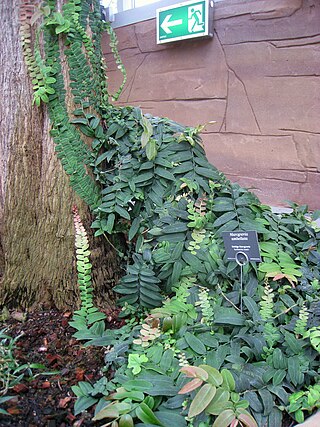
Hevea brasiliensis, the Pará rubber tree, sharinga tree, seringueira, or most commonly, rubber tree or rubber plant, is a flowering plant belonging to the spurge family, Euphorbiaceae, originally native to the Amazon basin, but is now pantropical in distribution due to introductions. It is the most economically important member of the genus Hevea because the milky latex extracted from the tree is the primary source of natural rubber.

The Mexican free-tailed bat or Brazilian free-tailed bat is a medium-sized bat native to North, Central, and South America and the Caribbean, so named because its tail can be almost half its total length and is not attached to its uropatagium. It has been claimed to have the fastest horizontal speed of any animal, reaching top ground speeds over 99 mph (160 km/h). It also flies the highest among bats, at altitudes around 3,300 m (10,800 ft).

Carl Friedrich Philipp von Martius was a German botanist and explorer. Between 1817 and 1820, he travelled 10,000 km through Brazil while collecting botanical specimens. His most important work was a comprehensive flora of Brazil, Flora Brasiliensis, which he initiated in 1840 and was completed posthumously in 1906.

The cookiecutter shark, also called the cigar shark, is a species of small squaliform shark in the family Dalatiidae. This shark lives in warm, oceanic waters worldwide, particularly near islands, and has been recorded as deep as 3.7 km (2.3 mi). It migrates vertically up to 3 km (1.9 mi) every day, approaching the surface at dusk and descending with the dawn. Reaching only 42–56 cm (16.5–22 in) in length, the cookiecutter shark has a long, cylindrical body with a short, blunt snout, large eyes, two tiny spineless dorsal fins, and a large caudal fin. It is dark brown, with light-emitting photophores covering its underside except for a dark "collar" around its throat and gill slits.

The Brazilian teal or Brazilian duck is the only duck in the genus Amazonetta. It is widely distributed in eastern South America.

Schinopsis is a genus of South American trees in the family Anacardiaceae, also known by the common names quebracho, quebracho colorado and red quebracho. In Brazil it is known as baraúna or braúna.

The giant otter or giant river otter is a South American carnivorous mammal. It is the longest member of the weasel family, Mustelidae, a globally successful group of predators, reaching up to 1.8 m. Atypical of mustelids, the giant otter is a social species, with family groups typically supporting three to eight members. The groups are centered on a dominant breeding pair and are extremely cohesive and cooperative. Although generally peaceful, the species is territorial, and aggression has been observed between groups. The giant otter is diurnal, being active exclusively during daylight hours. It is the noisiest otter species, and distinct vocalizations have been documented that indicate alarm, aggression, and reassurance.

The Marcgraviaceae are a neotropical angiosperm family in the order Ericales. The members of the family are shrubs, woody epiphytes, and lianas, with alternate, pinnately nerved leaves. The flowers are arranged in racemes. The flowers are accompanied by modified, fleshy, saccate bracts which produce nectar. The flowers are pentamerous. The fruits are capsules.

Holochilus brasiliensis, also known as the Brazilian marsh rat or web-footed marsh rat, is a species of semiaquatic rodent from South America. It is found in northeastern Argentina, southern and eastern Brazil and in eastern Uruguay.

Paracoccidioides brasiliensis is a dimorphic fungus and one of the two species that cause paracoccidioidomycosis. The fungus has been affiliated with the family Ajellomycetaceae although a sexual state or teleomorph has not yet been found.

Marcgravia is a genus of plants in the Marcgraviaceae family commonly eaten by the dwarf little fruit bat. The genus is native to the Caribbean Islands, Central America, and South America, and genus is named in memory of the German naturalist Georg Marcgraf. The plant is visited by Thomas's nectar bat.

Senecio brasiliensis, known by the common name flor-das-almas, (flower-of-souls), is a perennial species of the genus Senecio and family Asteraceae. It is native to fields and meadows of central South America.

Marcgravia umbellata, also called monkey paws, is a species of flowering vine in the family Marcgraviaceae. It is native to the Lesser Antilles islands in the eastern Caribbean and Anguilla. They are part of the guild photoautotroph. Marcgravia umbellata was the first member of the marcgraviaceae family to be described in modern botanical literature.
Jacques Denys (Denis) Choisy was a Swiss Protestant clergyman and botanist.

Epiperipatus brasiliensis is a species of velvet worm in the Peripatidae family. Males of this species have 29 pairs of legs; females have 31 or 33. This species ranges from 37 mm to 80 mm in length. The type locality is in Pará, Brazil. Epiperipatus vagans from Barro Colorado Island (Panama) was originally described as subspecies of Epiperipatus brasiliensis, but is now treated as a full species.

Paracoccidioides lutzii is a dimorphic fungus that is one of the causal agents of paracoccidioidomycosis, together with Paracoccidioides brasiliensis. Unlike P. brasiliensis, which is found throughout Central and South America, P. lutzii is found only in Brazil and Ecuador. It is less virulent than P. brasiliensis.

Souroubea is a genus of flowering plants in the family Marcgraviaceae, native to southern Mexico, Central America, Trinidad, and northern South America. Some species are psychophilous, and some are sphingophilous.
Norantea is a genus of flowering plants belonging to the family Marcgraviaceae.

Schwartzia is a genus of flowering plants belonging to the family Marcgraviaceae. It is found in tropical parts of South America, mainly within the rainforest. It has greenish, white, reddish or red coloured flowers.

Marcgravia pittieri is a species of flowering plant in the family Marcgraviaceae. It is visited by Thomas's nectar bat.

















